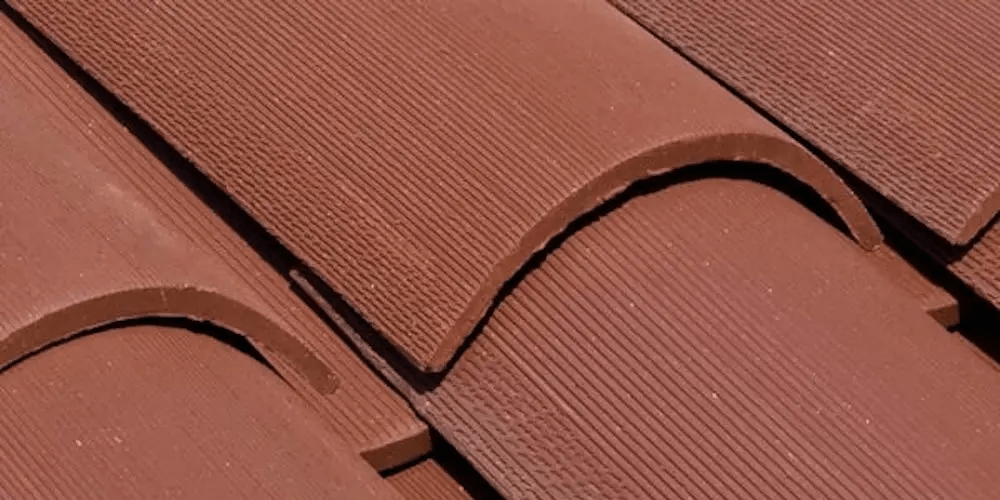Clay tile roofs are some of the oldest roofing materials available, dating back thousands of years. While there are several different styles of clay terracotta roofs, the Spanish-style tiles became popular in the American Southwest and Southeast due to their ability to transfer heat in hotter climates like California and Florida. If you're interested in installing clay tiles for your roof, let's take a look at why you should consider buying Mediterranean Spanish tiles.
About Spanish Tiles

Image source: Verea
What really separates Spanish tiles from other clay roofing tiles, including the similar-looking Mission-style barrel tiles? Spanish tiles are made into a rounded "S" shape and don't feature covers and pans seen on Mission-style and other clay roofing tiles. Due to their uniform design, Spanish tiles can't be staggered and are more difficult to install. However, both Mission-style and Spanish tiles require eave closures to protect the roof deck from moisture and pests like insects and birds.
Pros and cons of Spanish Tile

Image source: Renaissance Tile & Slate
Pros of Spanish Tiles
Eco and environmentally friendly - Because Spanish tiles and other clay roofing tiles are made from natural materials and can easily be recycled, they are incredibly environmentally friendly.
Fire and heat resistant - Not only do clay tiles reflect solar radiant heat, but they help insulate your home in the colder months. Thanks to the curve in Spanish tiles' appearance, it's able to ventilate and keep hot air out. In addition to being resistant to heat, clay tiles are also fire resistant, receiving a Class A fire rating.
Low maintenance - While installing a new roof of Spanish tiles can set you back financially, you likely won't have to spend much on repairs. Even homeowners located in more volatile climates with hurricanes or tornadoes can expect their clay tiles to withstand high winds.
Long lifespan - Thanks to its durability in severe weather conditions, Spanish tiles will literally last a lifetime, potentially up to 100 years or more. Thanks to the longevity of these tiles, many companies like Ludowici will offer lengthy warranties on them, some of which can last as long as 75 years.
Increases curb appeal - While installing a new roof alone can increase your home's value up to $15,000, clay roofs can sell even faster than other roofing products like asphalt shingles. Because of its long lifespan, environmentally friendly materials, and rustic aesthetically pleasing appearance, clay tiles can increase your home's value.
Cons of Spanish Tiles
Expensive - Perhaps the biggest downside to installing Spanish tiles is its high pricing. Not only are materials expensive, but the roof installation is also more difficult, is not DIY-friendly, and requires professional roofing contractors.
Fragile - Though Spanish tiles can withstand most severe weather conditions, they are prone to cracking or breaking from heavy impact or cold temperatures. Clay tiles often perform better in warmer, drier climates.
Heavy - Clay and concrete tiles are both extremely heavy and may even require structural reinforcement or a home inspection at least. One square of clay tiles can weigh between 800-1,250 pounds, so it's recommended to also check on the underlayment and the rest of the roof system to meet local building codes.
Roof slope requirements - Most roofing materials have a minimum slope requirement or you may violate your warranty and building codes, in addition to poor performance and further roof costs. Many materials like clay tiles, wood shakes, slate, and metal roofing typically require a 4:12 roof slope.
Colors and Styles of Spanish Tile
One of the perks of selecting Spanish tiles is choosing which colors and styles suit your needs. Ludowici features more than 50 different color tones and even offers barrel tiles with different textures with weathered patterns, smooth, and scored tiles to reduce the amount of glare and enhance the appearance of your roof. Let’s take a look at some of the different styles and custom colors of Spanish tiles available.
Traditional terracotta

Ludowici’s Medium Machine Scoring. Image source: Ludowici
When you think of clay tiles, the most common color that comes to mind is traditional terracotta. These colored tiles offer a warm, rustic appearance that gives your roof a ripple effect.
Patterned

Image source: Claymex
If you’re looking for a more textured appearance with a roof that sticks out more, patterned Spanish tiles offer different shades of color which help it stand out.
Brown

Image source: Claymex
There are darker shades to accentuate your home, but bear in mind that darker colors tend to absorb more heat than lighter colors. In addition to these three different color tones, there’s also a variety of other specialty colors like green, blue and more.
Spanish tile roof: in summary
If you’re interested in installing Spanish tiles for your roof, keep in mind that these tiles perform best if you live in a drier climate with less moisture. Although they are more expensive than most roofing materials, they are also one of the most aesthetically pleasing and longest-lasting materials available. A Spanish tile roof can withstand most severe weather, including extreme heat, hurricane winds, and hail, but can damage easily when hit by falling debris. Nonetheless, installing Spanish tiles is still a worthy investment that could last a lifetime and increase the value of your home.
Chris Gennone is a content specialist and video producer at Fixr.com. He has 5 years of experience writing and editing for a variety of web and print publications, currently specializing in home improvement projects such as roofing, remodeling, and repairs. When Chris isn’t writing or in front of the camera, he’s either playing with his band or tracking down the best sandwich shops.
